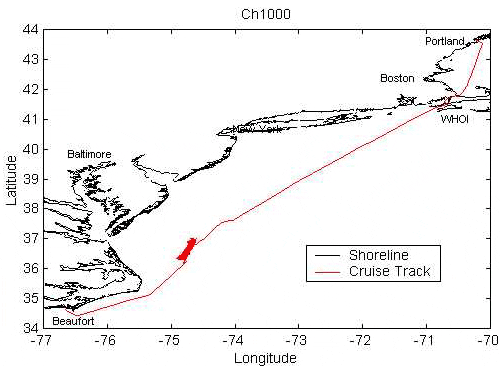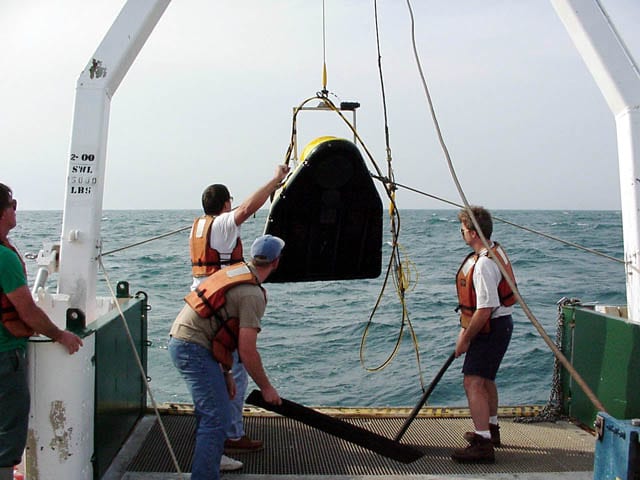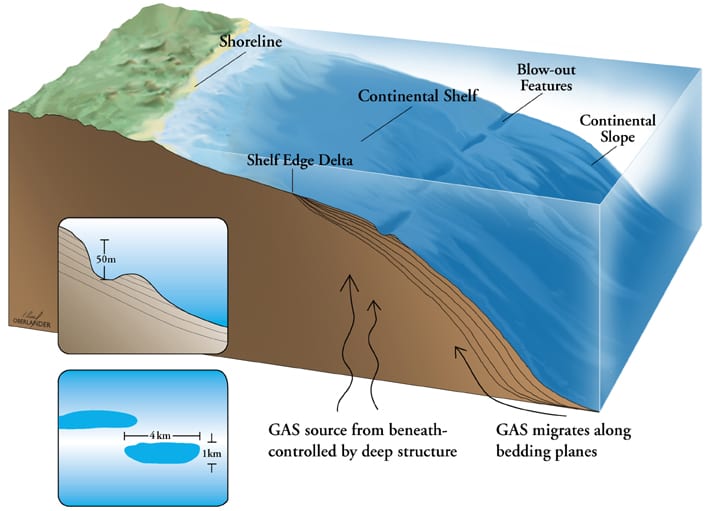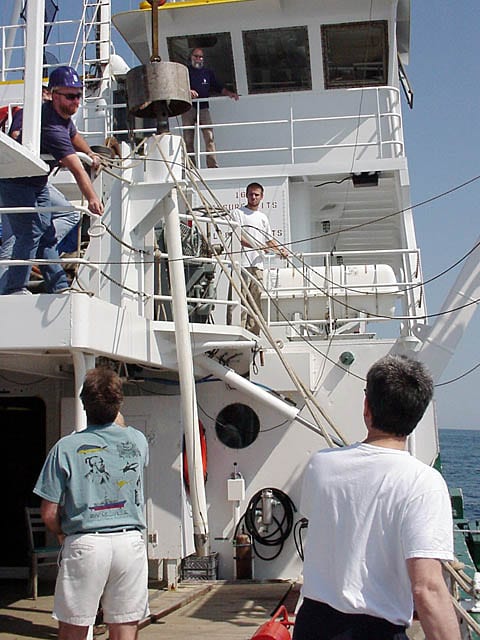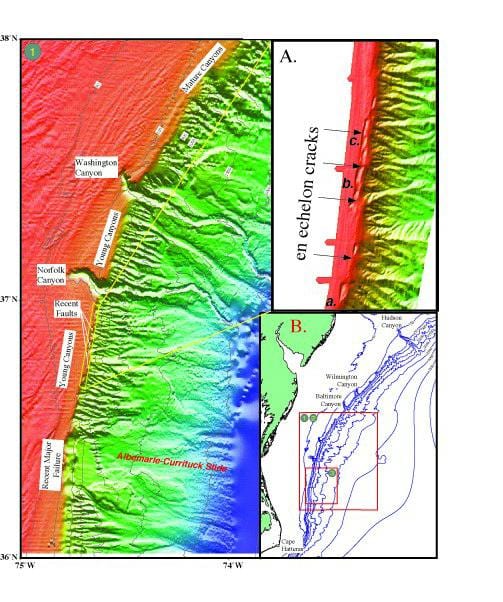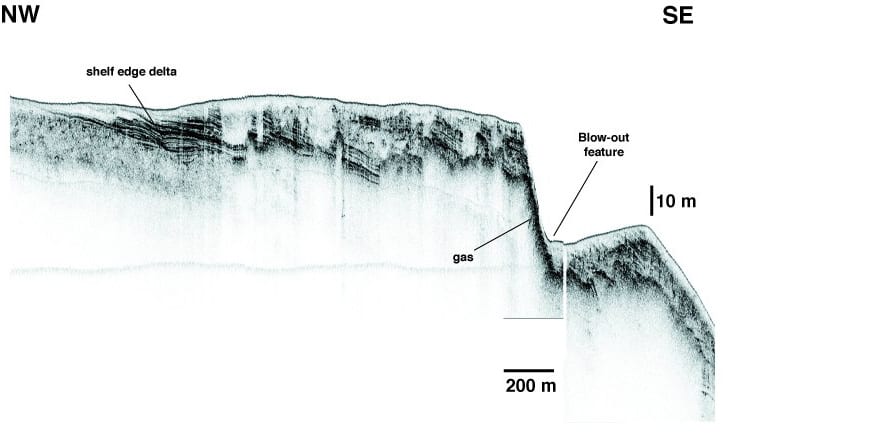Gas found off Mid-Atlantic Coast
May 30, 2000
Woods Hole, MA – A team of scientists investigating whether possible cracks along the outer continental shelf off the mid-Atlantic coast might lead to a tsunami-causing landslide has discovered that the entire area is charged with gas.
Based on preliminary results from a just-completed two-week cruise to the area, the scientists say the suspected cracks are a system of large depressions along the shelf edge that appear to have been excavated by gas erupting through the seafloor.
“We do not know the source of the gas,” team leader Neal Driscoll of the Woods Hole Oceanographic Institution (WHOI) said. “But it is clear that gas has played an important role in the formation of these features. The gas is trapped under layers of sediment on the shelf edge until some circumstance causes it to escape, blowing holes in the seafloor to form these large pockmark features we thought were cracks.”
In a paper published in the journal Geology days before their May 7 departure for the Mid-Atlantic coast, Driscoll and colleagues Jeffrey Weissel of the Lamont-Doherty Earth Observatory of Columbia University and John Goff of the University of Texas Institute for Geophysics had speculated that rising gas might play a part in triggering shelf-edge collapse. Even so, they were surprised at the quantity of gas and the apparent vigor of the “blowout” process.
“Our seismic data show that gas is pervasive in and around the blow-outs,” Goff said. “Gas has a characteristic signal, which commonly shows up as a bright, high-amplitude reflection that obscures any deeper signals.”
“We were a bit taken aback, to be sure,” Weissel said. “A great deal more work is needed before any definitive statements can be made. Regardless of the source, it is apparent that gas charging plays a critical role in the area, and that the ongoing process of blowouts could conceivably weaken the shelf edge and contribute to a submarine landslide/tsunami scenario.”
“What we can say with some confidence is that these blowout features occur where they do because layers of relatively impermeable sediment draped over the edge of the shelf form a trap that catches and accumulates the gas,” Goff said. “This allows pressure to build until the gas breaks through the seafloor, presumably throwing sediment up into the water column where it is carried away by the bottom currents.”
The scientists say the features, some as large as 1,500 meters (4,920 feet) across, 50 meters (165 feet deep) and up to 5,000 meters (16,400 feet) long, occur in a line along the shelf edge. That suggests there is some geological mechanism at work underneath the features, or their trend and shapes might be due to their proximity to the shelf edge. A submarine landslide and resulting tsunami along the shelf, although a very low risk when compared to the chance of hurricanes and severe storms striking the area, remains possible.
The May 7-20 research cruise was funded under a grant from the Marine Geology & Geophysics program of the National Science Foundation (NSF), and was conducted aboard the Research Vessel Cape Hatteras, operated out of Beaufort, North Carolina, by Duke University. The NSF grant will also cover the next year of data synthesis and analysis, and the eventual publication of the detailed results.
The section of continental shelf in question is known to be landslide-prone-an enormous slide occurred just to the south some 16,000 to 18,000 years ago at the end of the last ice age. But whether that long-ago collapse resulted from a similar process of gas charging and shelf-edge blowouts, and if so when the next one might occur, remains to be determined.
These confining layers appear to be remnants of an ancient delta that reached far out from the current coastline during the last ice age, when sea levels were much lower than today, Driscoll said. “We recovered samples of silty clay, sand and gravel from the bottom that are consistent with a deltaic setting. Where these deposits are absent, the gas appears to percolate harmlessly to the surface,” Driscoll said.
“The apparent size and violence of the gas-release episodes does concern us as they could pose hazards in and of themselves,” Weissel said. “Shallow gas blow-outs have damaged or destroyed oil drilling rigs in the Gulf of Mexico and the North Sea – something we should keep in mind when future work is conducted here.”
The primary tool used during the recent cruise was SUBSCAN, a state-of-the-art seafloor and sub-bottom imaging system, designed by EdgeTech of Boca Raton, Florida in collaboration with researchers at Florida Atlantic University and Woods Hole Oceanographic Institution. The device, towed behind the ship over the seafloor, was in the water 24 hours a day for eleven straight days, enabling the team to return home with more than 2,000 kilometers (1,250 miles) of geophysical data. The team also took sediment core samples in several locations using a gravity core.
The scientists rotated on 12-hour watches to monitor the equipment, record the data and make preliminary interpretations as it rolled in. The ship travelled back and forth over the study area in a pattern known as “mowing the lawn,” creating a dense grid of overlapping data sections.
Although they now know that gas expulsion is the primary force at work on the shelf edge, the teams says further research will be necessary to completely unravel the story and determine the real risk to adjacent coastal communities of a submarine landslide and associated tsunami.
Additional work will take a closer look into the subsurface to determine what is happening at depth. Collecting more samples of the sediments involved to determine age and timing is important, as is determining the origin of the gas and whether the venting process supports any specialized biological activity.
“When it comes to science, surprise is generally a good thing,” Driscoll said. “You have to approach any research effort with an open mind, willing to rethink your working hypothesis as new data comes in. This is a fascinating area of research, and we’ve only just begun to understand the processes at work.”
Still images and video available to the news media upon request
Additional Contact Information:
Shelley Lauzon
Media Relations Director
Woods Hole Oceanographic Institution
508-289-2270
slauzon@whoi.edu
Kurt Sternlof
Senior Science Writer
Columbia Earth Institute
914-365-8747
kurt@ldeo.columbia.edu
Kathy Ellins
Program Manager
Institute for Geophysics
University of Texas at Austin
512-232-3251
kellins@utig.ig.utexas.edu
Cheryl Dybas
Office of Legislative and Public Affairs
National Science Foundation
703-306-1070
cdybas@nsf.gov

